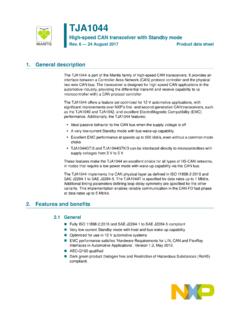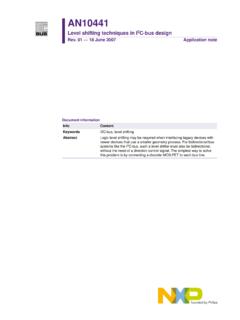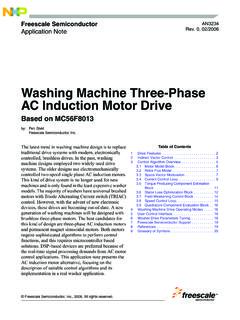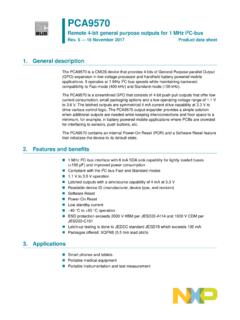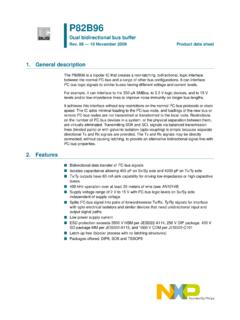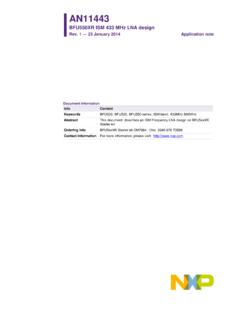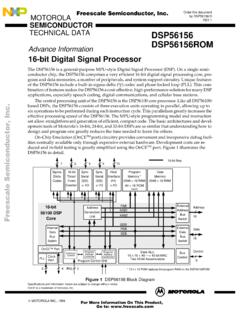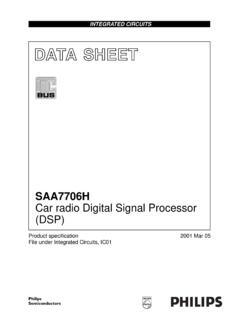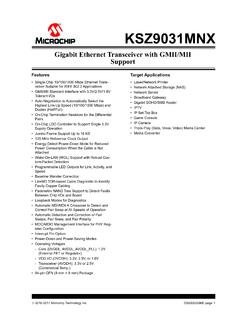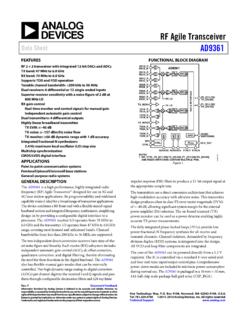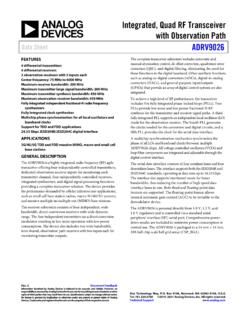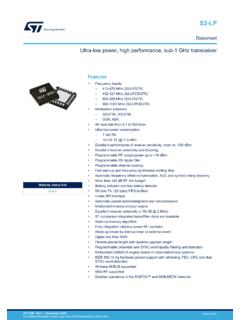Transcription of 1. General description - NXP
1 CAN. TJA1052i Galvanically isolated high-speed CAN transceiver Rev. 5 29 January 2018 Product data sheet 1. General description The TJA1052i is a high-speed CAN transceiver that provides a galvanically isolated interface between a Controller Area Network (CAN) protocol controller and the physical two-wire CAN bus. The TJA1052i is specifically targeted at Electric Vehicles (EV) and Hybrid Electric Vehicles (HEV), where galvanic isolation barriers are needed between the high- and low-voltage parts. Safety: Isolation is required for safety reasons, eg. to protect humans from electric shock or to prevent the electronics being damaged by high voltages. Signal integrity: The isolator uses proprietary capacitive isolation technology to transmit and receive CAN signals.
2 This technology enables more reliable data communications in noisy environments, such as high-voltage battery management systems or the drive and regeneration systems in EVs and HEVs. Performance: The transceiver is designed for high-speed CAN applications in the automotive industry, supplying the differential transmit and receive capability to a CAN. protocol controller in a microcontroller. Integrating the galvanic isolation along with the transceiver in the TJA1052i removes the need for stand-alone isolation. It also improves reliability and system performance parameters such as loop delay. The TJA1052i belongs to the third generation of high-speed CAN transceivers from NXP. Semiconductors, offering significant improvements over first- and second-generation devices.
3 It offers improved ElectroMagnetic Compatibility (EMC) and ElectroStatic Discharge (ESD) performance, and also features ideal passive behavior to the CAN bus when the transceiver supply voltage is off. The TJA1052i implements the CAN physical layer as defined in ISO 11898-2:2016 and SAE J2284-1 to SAE J2284-5. This implementation enables reliable communication in the CAN FD fast phase at data rates up to 5 Mbit/s. The TJA1052i is an excellent choice for all types of automotive and industrial CAN. networks where isolation is required for safety reasons or to enhance signal integrity in noisy environments. 2. Features and benefits General Isolator and transceiver integrated into a single SO16 package, reducing board space ISO 11898-2:2016 and SAE J2284-1 to SAE J2284-5 compliant Timing guaranteed for data rates up to 5 Mbit/s in the CAN FD fast phase Flawless cooperation between the Isolator and the transceiver NXP Semiconductors TJA1052i Galvanically isolated high-speed CAN transceiver Fewer components improves reliability in applications Guaranteed performance (eg.)
4 Max loop delay <220 ns). Electrical transient immunity of 45 kV/ s (typ). AEC-Q100 qualified Suitable for use in 12 V and 24 V systems; compatible with 3 V to 5 V microcontrollers Bus common mode voltage (Vcm) = 25 V. Low ElectroMagnetic Emission (EME) and high ElectroMagnetic Immunity (EMI). Dark green product (halogen free and Restriction of Hazardous Substances (RoHS). compliant). Power management Functional behavior predictable under all supply conditions transceiver disengages from the bus when not powered up (zero load). Protection Up to 5 kV (RMS) rated isolation Three versions available (1 kV, kV and 5 kV). Voltage compliant with UL 1577, IEC 61010 and IEC 60950. 5 kV (RMS) rated isolation voltage compliant with UL 1577, IEC 61010 and IEC 60950.
5 Supports ISO6469 Electrically propelled road vehicles. Safety specifications.'. High ESD handling capability on the bus pins Bus pins protected against transients in automotive environments Transmit Data (TXD) dominant time-out function Undervoltage detection on supply pins 3. Quick reference data Table 1. Quick reference data Symbol Parameter Conditions Min Typ Max Unit IDD1 supply current 1 VTXD = 0 V; bus dominant - - mA. VTXD = VDD1; bus recessive - - mA. IDD2 supply current 2 VTXD = 0 V; bus dominant; 60 load - - 70 mA. VTXD = VDD1; bus recessive - - 10 mA. Vuvd(swoff)(VDD2) switch-off undervoltage - V. detection voltage on pin VDD2. VESD electrostatic discharge voltage IEC 61000-4-2 at pins CANH and CANL 8 - +8 kV.
6 VCANH voltage on pin CANH 58 - +58 V. VCANL voltage on pin CANL 58 - +58 V. Tvj virtual junction temperature 40 - +150 C. Tamb ambient temperature 40 - +125 C. TJA1052I All information provided in this document is subject to legal disclaimers. NXP Semiconductors 2018. All rights reserved. Product data sheet Rev. 5 29 January 2018 2 of 27. NXP Semiconductors TJA1052i Galvanically isolated high-speed CAN transceiver 4. Ordering information Table 2. Ordering information Type number Package Name description Version TJA1052IT/5 SO16 plastic small outline package; 16 leads; body width mm SOT162-1. TJA1052IT/2. TJA1052IT/1. Table 3. Voltage ratings Type number Rated insulation voltage according to UL 1577, IEC 61010 and IEC 60950.
7 TJA1052IT/5 5 kV (RMS). TJA1052IT/2 kV (RMS). TJA1052IT/1 1 kV (RMS). 5. Block diagram 9'' 9'' .. 9'' . 7(03(5$785( 7-$ L. 3527(&7,21.. &$1+. 6/23(. &21752/ . 7;' 7,0( 287 $1'. ,62/$7,21 %$55,(5. '5,9(5.. &$1/. 02'(. &21752/. *1' . 08;.. 5;' $1'. '5,9(5. :$.( 83. ),/7(5.. *1' 67% *1' DDD . Fig 1. Block diagram TJA1052I All information provided in this document is subject to legal disclaimers. NXP Semiconductors 2018. All rights reserved. Product data sheet Rev. 5 29 January 2018 3 of 27. NXP Semiconductors TJA1052i Galvanically isolated high-speed CAN transceiver 6. Pinning information Pinning 9'' 9'' . *1' *1' . 7;' 67%. Q F &$1+. 7-$ L. 5;' &$1/. Q F 9'' . *1' *1' . *1' *1' . DDD.)))))))))))
8 Fig 2. Pin configuration diagram Pin description Table 4. Pin description Symbol Pin description VDD1 1 supply voltage 1. GND1 2 ground supply 1[1]. TXD 3 transmit data input n/c 4 not connected RXD 5 receive data output; reads out data from the bus lines n/c 6 not connected GND1 7 ground supply 1[1]. GND1 8 ground supply 1[1]. GND2 9 ground supply 2[1]. GND2 10 ground supply 2[1]. VDD2 11 supply voltage 2. CANL 12 LOW-level CAN bus line CANH 13 HIGH-level CAN bus line STB 14 Standby mode control input[2]. GND2 15 ground supply 2[1]. VDD2 16 supply voltage 2. [1] All GND1 pins (pins 2, 7 and 8) should be connected together and to ground domain 1. All GND2 pins (pins 9, 10 and 15) should be connected together and to ground domain 2.
9 Refer to the application notes for further information. [2] Setting STB HIGH disables the CAN bus connection. TJA1052I All information provided in this document is subject to legal disclaimers. NXP Semiconductors 2018. All rights reserved. Product data sheet Rev. 5 29 January 2018 4 of 27. NXP Semiconductors TJA1052i Galvanically isolated high-speed CAN transceiver 7. Functional description Operation Normal mode During normal operation, the TJA1052i transceiver transmits and receives data via bus lines CANH and CANL (see Figure 1 for the block diagram). The differential receiver converts the analog data on the bus lines into digital data, which is output on pin RXD. The slopes of the output signals on the bus lines are controlled internally and are optimized in a way that guarantees the lowest possible EME.
10 The isolator used in the TJA1052i is an AC device that employs on-off keying to guarantee the DC output state at all times. The states of TXD, RXD and the CAN bus at start-up, shut-down and during normal operation are described in Table 5. Care should be taken regarding power sequencing if the device is used in networks that support remote wake-up (see Section 12 Application information ). Table 5. Input/output states at start-up, shut-down and during normal operation TXD RXD VDD1 VDD2 CAN Comments H H >Vuvd(VDD1) >Vuvd(stb)VDD2) recessive Normal mode operation L L >Vuvd(VDD1) >Vuvd(stb)VDD2) dominant Normal mode with TXD dominant time-out active X X unpowered >Vuvd(stb)VDD2) dominant dominant after VDD1 power loss until TXD dominant timeout; recessive while VDD2 is ramping up from an unpowered state X L >Vuvd(VDD1) unpowered disconnected RXD transitions L-to-H when VDD2 restored Standby mode The TJA1052i cannot transmit or receive regular CAN messages in Standby mode.
